Tiruchchirappalli, Tamil Nadu, India
Tiruchchirappalli, or Trichy, lies at the head of the Cauvery river delta. A Chola citadel in the 1st century BCE, it was an important regional capital of the Pallava, Pandyas, Chola, and Vijayanagar kings from the 7th to the 17th century, and the scene of bitter fighting between Muslim, Maratha, British, and French troops from the 17th to the 19th century. [Adapted from Encyclopedia Britannica]
|
Sri Jambukeshwara Temple
Built in the 10th century CE, this temple, dedicated to Shiva and Parvati, is known for its fine gopurams. Gopurams are the entrance gateways to temples in South India. They grew in size from the mid-12th century CE until the colossal ones came to dominate the temple complex, surpassing the main sanctum for architectural elaboration. Often a series of gopurams are to be found at a shrine, each providing entry through a new enclosure wall. The gopuram is generally constructed with a stone base and a superstructure of brick and pilaster. It is rectangular in plan and topped by a barrel-vault roof. The exterior walls are covered with sculpture. [Adapted from Encyclopedia Britannica] |
|||
|
Outermost gopuram 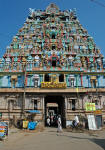 |
Divine battle 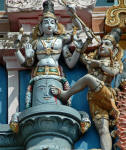 |
||
Zooming in  |
Ravana?  |
||
Song and dance? 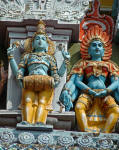 |
Push, push  |
Gateway sentry  |
Dreadlocks 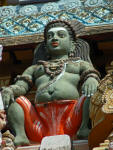 |
Second gopuram 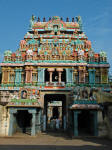 |
Third gopuram w/ mandapa 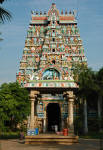 |
Third gopuram  |
Third gopuram detail  |
Comfy sitting? 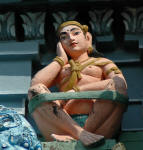 |
Ravana? 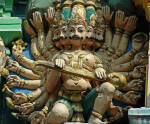 |
||
Krishna with gopis  |
Krishna with gopis  |
||
Path to the inner sanctum  |
Pillared hallway  |
Center of the hall  |
Pillar detail  |
Fourth gopuram  |
Courtyard sculpture  |
Fifth gopuram 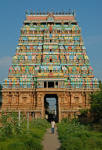 |
Beggar woman  |
|
Sri Ranganathaswamy Temple (Srirangam)
Ramanuja (1017-1137 CE), the single most influential thinker of devotional Hinduism, settled down at Srirangam, where he organized temple worship and founded centers to disseminate his doctrine of devotion to Vishnu and his wife Sri. He taught that the worship of a personal god and the soul's union with him is an essential part of the doctrines of the Upanishads on which the system of Vedanta is built; therefore, the teachings of the Vaishavas and Bhagavatas (devotees of Vishnu) are not heterodox. His influence on the course of Hinduism was profound. By embedding the urge for devotional worship (bhakti) into his doctrine of salvation, he aligned the popular religion with the pursuits of philosophy and gave bhakti an intellectual basis. Ever since, bhakti has remained the dominant flavor of Hinduism. [Adapted from Encyclopedia Britannica] Today the vast temple complex is a noisy little town. An example of a still-popular ancient temple that is ill-maintained (unlike the nearby Jambukeshwar temple, or the Meenakshi temple at Madurai), it seethes with half-naked priests with painted foreheads hell-bent on preventing cameras inside and keeping non-Hindus out of it, a disturbing practice not uncommon in Tamil Nadu temples. Until the efforts of Gandhi and Ambedkar in the 1930s, the "untouchables" too were not allowed in. At the temple Namit met a retired civil engineer in traditional attire, escorting his 90+ mother. Mixing mystical ideas with reason, he criticized the temple's orthodox priests and rituals. "You must stay away from temples," he said, adding mischievously, "what do you think happens to all the sticky sin that others unload here?" |
|||
Entrance gopuram (more) 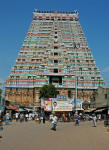 |
Second gopuram 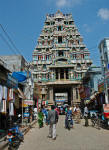 |
Third gopuram  |
Fourth gopuram 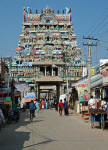 |
Road through gopuram  |
Riotous sculpture  |
Hallway behind inner sanctum  |
Around the inner sanctum 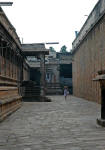 |
|
Rock Fort Temple |
|||
|
Built by the Nayaks of Madurai 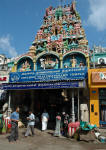 |
Relief sculpture near entrance  |
Vinayaka (Ganesh) temple  |
Shiva temple  |
|
Miscellaneous pictures |
|||
|
Trichy on the Cavery (more)  |
Trichy roads  |
Brick & mortar jungle?  |
Another view of Trichy  |
Cauvery river  |
Lourdes church  |
Girl leading blind woman  |
"High class" restaurant  |
Designed in collaboration with Vitalect, Inc. All rights reserved. |








